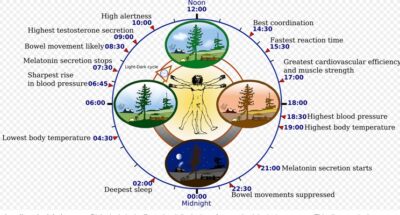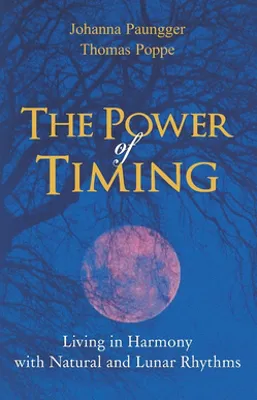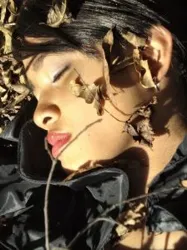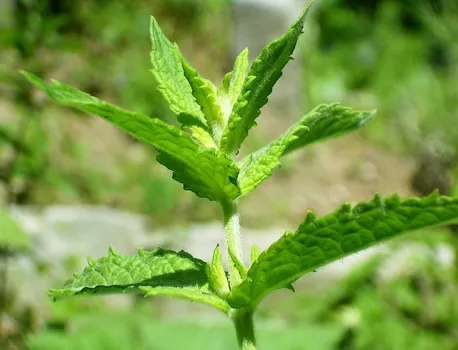
Hair Growth And Circadian Rhythms
 Long Blonde Hair - Photo by Todd Trapani on Unsplash
Long Blonde Hair - Photo by Todd Trapani on UnsplashScientists who have undertaken a series of studies have determined that there is a direct and measurable link between hair growth cycles and circadian rhythms.[1]
Chronobiology is the study of circadian rhythms.
Humans fall into three types of circadian rhythm patterns.
Larks, Owls, and Intermediates
The types are tied to what time of day humans are more awake and alert in a 24-hour cycle.
Humans with early circadian rhythms are known as larks, while later ones are known as owls. The third group of individuals is referred to as intermediate.
What Are Circadian Rhythms?
 Circadian Rhythm Diagram
Circadian Rhythm DiagramAccording to NIH.Gov, circadian rhythms are physical, mental, and behavioral changes that follow a 24-hour cycle.
These natural processes respond primarily to light and dark.
They affect most living things, including humans, animals, plants, and microbes.
Hair Growth Cycles And Circadian Clock Cycles
 Photo by Jenna Anderson on Unsplash
Photo by Jenna Anderson on UnsplashOnce hair growth has passed from the anagen phase, clock genes express themselves in the hair cells at the bottom of the hair follicle.
Note: The three stages of hair growth are the anagen, catagen, and telogen phases.
The circadian clock differs among the phases of the hair growth cycle.[2]
The circadian clock can adjust how the hair stem cells are turned off or on, which controls the hair growth cycles.
Stem Cell Genes May Be Affected
Through a clock gene called BMAL1, stem cell genes can be affected to become more or less active.
Mutations might occur in the clock genes. This might include the deletion of BMAL1. Stem cells may become inactive, which may lead to diminished hair growth. [3]
 Photo by Kareya Saleh on Unsplash - Model is Kirsten Zellers (@kirstenzellers) at Shag Salon (@shagboston) in Boston.
Photo by Kareya Saleh on Unsplash - Model is Kirsten Zellers (@kirstenzellers) at Shag Salon (@shagboston) in Boston.The circadian clock can adjust how the hair stem cells are turned off or on, which controls the entire hair growth cycle.
Results Of The Study
Results of the study indicate that sleep deprivation affects the circadian rhythm, which may affect hair growth cycles.
One study also demonstrated that sleep deprivation resulted in decreased beard hair growth.
Will getting more sleep every night trigger the growth of long and lusher hair?
There is good evidence that the hair follicle has a biological clock and may be directly connected to the body’s circadian rhythm.
Future Therapies Linked To Hair Growth And Circadian Rhythm Studies
 Photo by Lucy Dimitrova on Unsplash
Photo by Lucy Dimitrova on UnsplashPER1 and BMAL1 are potential targets for therapy in modulating hair growth by avoiding undesired effects on the central clock.
By blocking the activity of such genes, future therapies may prevent hair loss (alopecia).
By promoting the activity of these target genes, therapy may suppress unwanted hair growth (hirsutism).[4]
Melatonin regulates the sleep-wake cycles. It may influence the hair growth cycle. [5]
Topical application of melatonin may be a treatment option for those with female and male pattern hair loss, which may become available in the future.
Study References
[1] Stenn KS, Paus R. Controls of hair follicle cycling. Physiol Rev.2001;81(1):449-494; PMID: 11152763
[2] Plikus MV, Chuong CM. Complex hair cycle domain patterns and regenerative hair waves in living rodents. J Invest Dermatol.2008;128(5):1071-1080; PMID: 18094733
[3] Janich P, Pascual G, Merlos-Suarez A, et al. The circadian molecular clock creates epidermal stem cell heterogeneity. Nature.2011;480(7376):209-214; PMID: 22080954
[4] Al-Nuaimi Y, Hardman JA, Biro T, et al. A meeting of two chronobiological systems: circadian proteins Period1 and BMAL1 modulate the human hair cycle clock. J Invest Dermatol.2014;134(3):610-619; PMID: 24005054
[5] Fischer TW, Trüeb RM, Hänggi G, et al. Topical Melatonin for Treatment of Androgenetic Alopecia. Int J Trichology.2012;4(4):236-245; PMID: 23766606
Disclaimer: The information provided above is for entertainment purposes. Do not use this information as a substitute for medical advice.Social Media Network Information
Please follow us on Twitter at: https://Twitter.com/HairBoutique. I look forward to meeting new people from all walks of Twitter and learning from their Tweets.















